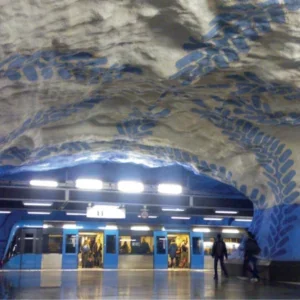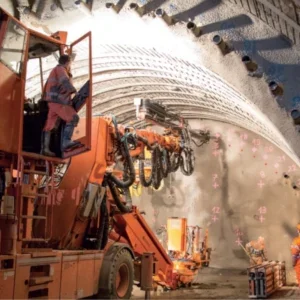Major tunnelling works in Singapore began with the decision in 1982 to implement a comprehensive mass rapid transit (MRT) system. Limited tunnelling had always been undertaken in Singapore, mainly for sewage and drainage works, often using square shields. The MRT project, however, was on a much larger scale and involved some 11km of twin tunnels of 5.2m i.d. constructed in a period of 31¼4 years between March 1984 and June 1987. Since then, a number of major projects using underground construction have been promoted and are either actively being implemented or are scheduled for the early years of the 21st century.
Earlier works
MRT Construction Phases 1 and 2
While the total length of tunnel was not great by world standards, the work comprised 38 separate tunnel drives2. The equipment used varied from Greathead-type shields with a backhoe or milling head for mechanised excavation to full face TBM with hydraulic face gates and EPB machines. Most of the tunnels were lined with precast concrete segments, with some 2km using in-situ concrete lining (Fig 1).
The main feature of the tunnel works were the rapid changes in geology within most drives. The three formations encountered were:
- Kallang Formation: recent deposits of soft clays and fluvial sands
- Jurong Formation: sedimentary series, mainly varying degrees of weathered sandstone ranging from competent rock through highly fractured/friable hard clay to medium stiff clay
- Bukit Timah Formation granite: fresh at depth, completely weathered approaching the ground surface, producing a silty clay
This variability was evident in the different soil types and the widely ranging soil parameters within any one type.
The main soil types encountered are described below:
- Marine clays: very soft to soft varying with depth. Sticky and not easy to handle. Required compressed air or ground treatment to form a stable face in an open shield. The favourite way of dealing with the marine clay was simply to push the shield into it in a blind type approach.
- Completely decomposed granite, medium stiff to stiff silty clay. Relatively low permeability. Compressed air preferred with an open shield. Boulders of fresh granite encountered in certain areas.
- Fluvial sands, very variable, which can range from loose, single size medium sands in lenses several metres thick to stiff, clayey sands with reasonably high cohesion and low permeability. Problems of ravelling and air loss.
- Weathered sedimentaries. When completely weathered, similar to the completely decomposed granite, except that they are somewhat stiffer and of a lower permeability. Free air tunnelling is possible. Beds of boulders were encountered in many areas. These are now thought to be a colluvium deposit rather than different degrees of weathering within the parent material. The borders can be very strong with an absence of jointing and compressive strengths of between 55 and 185 MN/m2. The moderately weathered sandstone appeared as hard clay, but very friable and gave ravelling problems in the tunnel face.
Central Expressway tunnels
The extension of the expressway road network proceeded concurrently with the implementation of the MRT. A key section was the Central Expressway, running roughly north/south down the centre of the island, where it passed through some of the most densely developed areas of Singapore (Fig 1). An at-grade motorway was obviously unacceptable in these locations and in consequence two sections, the first 700m long under Bukit Timah Road and the second, approx. 1.7km long under Orchard Road and the Singapore River were built in cut+cover. The twin tunnels each contain a 3-lane motorway and emergency walkway, with ventilation and other services. The cross section is approximately 40m wide and 8m high.
Cable tunnel to Pulau Seraya
An unusual immersed tube tunnel project was constructed in 1988 to convey electric cables from the power station on Pulau Seraya to the mainland (Fig 1). The route was 2.6km overall, with 1.8km deeper than 23m below msl. The cross section is 6.5m wide and 3.7m high. To simplify and speed construction, each immersed tube section comprised 28 x 3.5m long, match cast segments and one special end section. These were stressed together to form a 100m tube and placed in the usual manner. Although there was provision for epoxy resin grouting at the joints, it was not necessary to use it, the tunnel being remarkably water-tight3.
Tuas cable tunnel
Following successful completion of the above mentioned tunnel, utility company Power Grid constructed a similar tunnel across Tuas Bay at the western end of the island to house the 400kV and 230kV oil filled power cables, together with associated M&E equipment, for the transmission development project at Tuas. It was completed in 1998.
Underground caverns
In 1990, the Nanyang Technological University and the Public Works Department combined to study the feasibility of constructing rock caverns in the Bukit Timah Granite that underlies about one third of the land area of Singapore4. The results of the initial work were sufficiently favourable for further detailed studies to be undertaken. Investigations were extended to the Jurong Formation and studies showed that a number of locations in this formation were favourable for the potential development of caverns.
Pedestrian tunnels
As with any urban environment, pedestrian subways, mostly built by conventional cut+cover methods, are commonplace in Singapore. Two subways under busy Orchard Road were constructed by an unusual tunnelling method using pipejacking techniques to create an interlocked pipe arch and sidewalls. The subway was then excavated by tunnelling within the protection of the steel pipes.
Conclusion
These massive infrastructure projects are all proceeding on schedule, and financial problems, thanks to Singapore’s prudent fiscal policies, are not affecting implementation. The downturn in construction work in the Asia Pacific area has in some ways ensured the success of these projects, since a large pool of contractors is interested in competing for these attractive works. As a consequence, for the next five to ten years, Singapore is likely to be the busiest single centre of tunnelling activity in the world.
Related Files
Geological Profile
Tunnelling in Singapore






